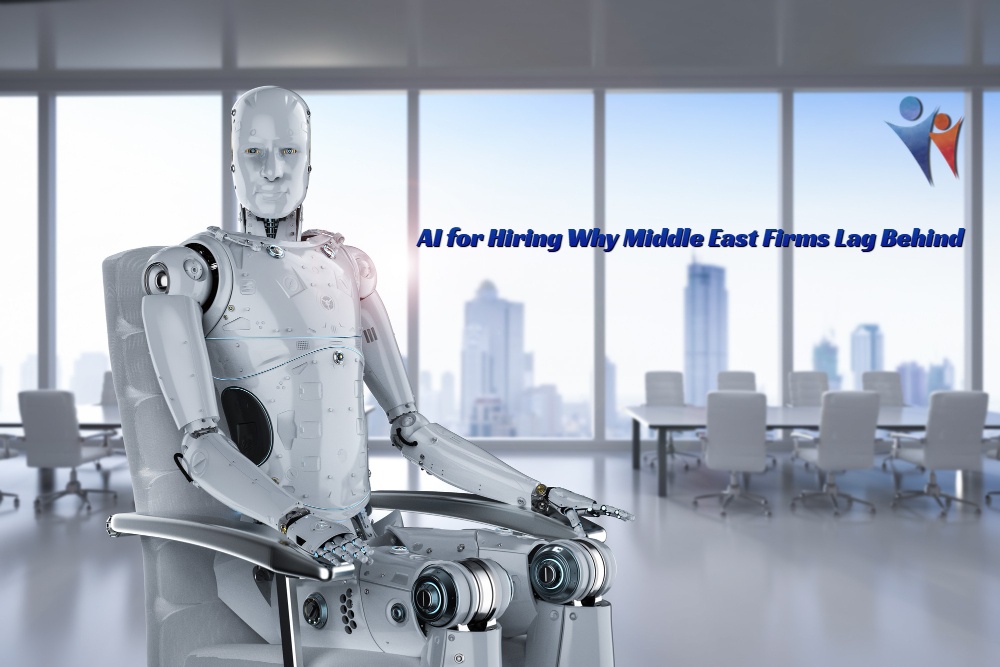In a world where AI for hiring is rapidly changing recruitment dynamics, many companies in the Middle East are trailing far behind. While global enterprises in the U.S., Europe, and parts of Asia aggressively invest in artificial intelligence to revolutionize their hiring processes, businesses across the Gulf Cooperation Council (GCC) and wider MENA region remain slow to adopt these innovative solutions.
This lag is more than just a technology gap; it could affect regional competitiveness, talent acquisition efficiency, and long-term workforce development. In this article, we explore the reasons behind this delay, the risks it poses, and what Middle East companies can do to catch up.
AI for Hiring Why Middle East Firms Lag Behind
The Global Rise of AI for Hiring
AI is now a fundamental part of modern recruitment. From scanning CVs and scheduling interviews to conducting video assessments and predicting candidate success, AI for hiring helps businesses streamline HR workflows, reduce time-to-hire, and improve candidate experience.
Companies like Amazon, Unilever, and Deloitte are leading examples of global firms that use AI for hiring to make smarter, faster, and less biased decisions. AI-based tools like HireVue, Pymetrics, and LinkedIn’s Talent Insights are becoming standard.
Why the Middle East Is Falling Behind
Despite the global trend, many Middle East firms, especially SMEs and traditional sectors, remain hesitant. There are several contributing factors:
1. Limited Awareness
Many HR professionals and decision-makers are not fully aware of what AI for hiring entails or how it adds value. Misconceptions and fear of job displacement further discourage exploration.
2. Cultural and Organizational Resistance
In many Gulf countries, traditional hiring methods like personal referrals, internal recommendations, and face-to-face interviews remain dominant. Adopting AI challenges these long-held practices.
3. Regulatory Ambiguity
AI use often involves data processing and analytics, which can raise compliance issues under data privacy laws. In some countries, the regulatory framework for AI in HR is still underdeveloped.
4. Cost of Implementation
While large multinationals can afford enterprise-level AI tools, local firms, especially in non-tech sectors, often lack the budget or IT expertise to deploy AI for hiring solutions effectively.
5. Shortage of Skilled Talent
There’s a gap in local expertise to build, manage, and maintain AI-driven HR platforms. Dependence on outsourced talent limits customization and innovation.
The Risks of Not Using AI for Hiring
Failing to adopt AI for hiring could expose Middle East companies to several disadvantages:
Longer Time-to-Hire: Manual screening and interviewing slow down the recruitment process.
Higher Costs: Traditional hiring methods often require more manpower and resources.
Limited Talent Insights: Companies without AI miss out on predictive analytics that could help forecast job fit and retention.
Bias and Inconsistency: Human decision-making can be prone to unconscious bias, something AI can help mitigate when designed properly.
Competitive Disadvantage: Global firms hiring remote talent using AI tools will have the edge in acquiring top candidates faster.
Benefits of AI for Hiring
Implementing AI for hiring can dramatically enhance recruitment in the Middle East:
Speed: Automates repetitive tasks like resume parsing and shortlisting.
Efficiency: Reduces HR workload, freeing up teams for strategic initiatives.
Candidate Experience: Chatbots and automated updates keep applicants informed.
Accuracy: AI can analyze thousands of profiles to find the best match.
Bias Reduction: Structured algorithms help make fairer hiring decisions.
Maintaining a 2% AI for hiring keyword density throughout your recruitment content also helps boost SEO and attract tech-savvy job seekers.
Case Studies: Who’s Getting It Right?
Some Middle East organizations are already exploring AI in HR, setting the pace for others:
Emirates Group: Uses AI-driven tools to filter through high volumes of applications for flight crew and tech roles.
Etisalat and STC: Telecom giants have piloted AI chatbots and analytics to improve internal and external hiring.
Saudi Aramco: Launched machine learning tools for internal promotions and succession planning.
These companies show how AI for hiring can be customized and applied at scale, even within traditional industries.
How Middle East Companies Can Adopt AI for Hiring
To move forward, companies need to take a strategic and phased approach:
1. Educate and Train HR Teams
HR teams must understand the benefits and practicalities of AI for hiring. Internal workshops and certifications from platforms like Coursera or LinkedIn Learning can help.
2. Pilot with Small Projects
Begin with one department or job role. Test an AI-powered resume screener or a chatbot for applicant FAQs. Measure results and scale accordingly.
3. Partner with Vendors
Work with reputable AI hiring platforms that provide region-specific compliance, language localization, and support.
4. Ensure Ethical Use
Implement bias checks, transparency, and consent in AI hiring workflows to comply with regional labor laws and build trust.
5. Invest in Tech Talent
Hire or train tech-savvy HR professionals who can bridge the gap between human resources and machine learning systems.
The Future of AI for Hiring in the Middle East
The talent war is intensifying, and the Middle East cannot afford to fall behind. With Vision 2030 initiatives in countries like Saudi Arabia and digital transformation goals across the GCC, AI adoption in HR will become inevitable.
Early adopters of AI for hiring will be better equipped to attract global talent, optimize operations, and improve employer branding. It’s not just about adopting a trend; it’s about redefining how companies hire in a data-driven future.
Conclusion
The lag in AI for hiring adoption among Middle East companies reflects deeper challenges around awareness, culture, and technology access. But the benefits—faster hiring, better candidates, and smarter decisions—are too great to ignore.

